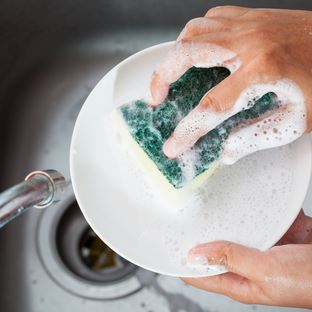Clean Dish Sponge Do's and Don'ts
How good is your knowledge of sponge bacteria facts? Sure, at some point or another, you’ve probably had someone tell you that your kitchen sponge is the filthiest item in your house. But did you believe it? Well, whether you were a believer or not, this fact is true according to Philip Tierno. He's a microbiologist and pathologist at the New York University School of Medicine.
And it makes sense. Not only is your sponge moist, making it easier for disease-causing bacteria to grow, it’s also covered in food particles. Essentially, you’re giving the bacteria everything they need to thrive. That’s not good, as you certainly don’t want to give dinner guests cramps and cold sweats or send the family running to the bathroom after a meal.
So what do you do? Familiarize yourself with the following clean dish sponge do’s and don’ts. They may decrease the chance of spreading foodborne pathogens to your friends and family.
Do use a microfiber sponge.
When you’re next looking for a new clean dish sponge to replace your worn out one, consider microfiber. You may notice that most manufacturers make no claims that microfiber reduces bacteria. Even so, the composition of the material lends itself to drying quickly. That means a microfiber sponge may not stay damp after it’s used as long as a cellulose sponge will. As a result, the time in which bacteria have to develop may be cut shorter.
Pro tip: Microfiber sponges are easy to find either online or in your local grocery store. They’re also not that expensive.
Do clean your sponges daily.
A clean dish sponge decreases your odds of spreading bacteria around your kitchen. Microwaving is one of the most effective methods of cleaning sponges. Simply place a completely wet sponge in the microwave for one to two minutes. Keep an eye on it while the microwave’s on. Give it time to cool before removing it. You can also wash your sponge in the dishwasher—with your dishes—as long as you’re using a heated dry setting.Do rinse and dry before storing.
You already learned the sponge bacteria facts about how food bits and dampness enable the growth of pathogens. Take steps to hinder their progress by rinsing your sponge well after cleaning. Once you’ve done that, you’ll want to wring as much water from the sponge as possible. Then store the sponge in an area where it can dry completely, like a small sponge rack. Avoid letting it rest in the bottom of the sink.Don’t use sponges on butcher’s blocks.
Because butcher’s blocks and cutting boards are used to prepare raw meat, they’re more prone to housing bacteria. Don’t use your everyday dishwashing and counter wiping sponge to clean these items. Instead, use a paper towel with manufacturer-recommended disinfectant or a bleach wipe. If you do use a sponge to wipe up meat juices, you’ll probably want to throw it away immediately afterwards. Better safe than sorry, right?Don’t keep sponges too long.
Have you ever kept a sponge so long that it starts to smell bad? That’s the smell of a happy colony of bacteria growing on the very item you use to clean your countertops and dishes. If you’re cleaning cellulose sponges daily, you may be able to get about two weeks’ use out of them. Microfiber sponges that are cleaned regularly might last as long as a month before they need replacing.Don’t use a dish cloth in place of a clean dish sponge.
Some people may prefer dish cloths to sponges. There are a couple of problems with this. First, dish cloths don’t dry out as quickly as sponges, so they may be more likely to grow bacteria. Additionally, many people don’t wash their dish cloths as often as they should. If you’re using a dish cloth in lieu of a clean dish sponge, you need to wash or replace the cloth on a daily basis.The next time you pick up that kitchen sponge, ask yourself how long it’s been since you cleaned or changed it. Now that you’re armed with these do’s and don’ts—as well as some sponge bacteria facts—you can keep your kitchen cleaner and healthier.













.2210140805553.jpg)
